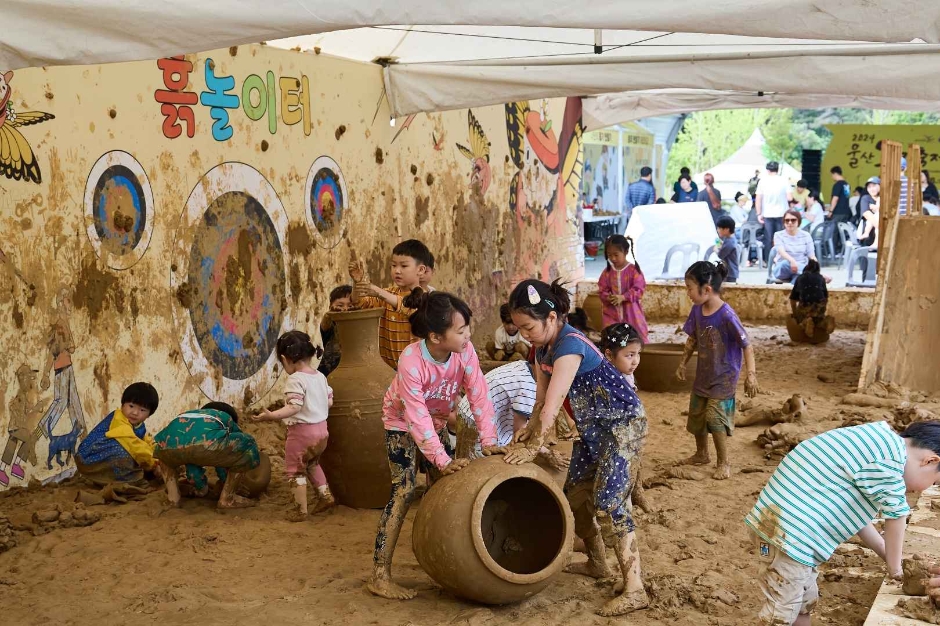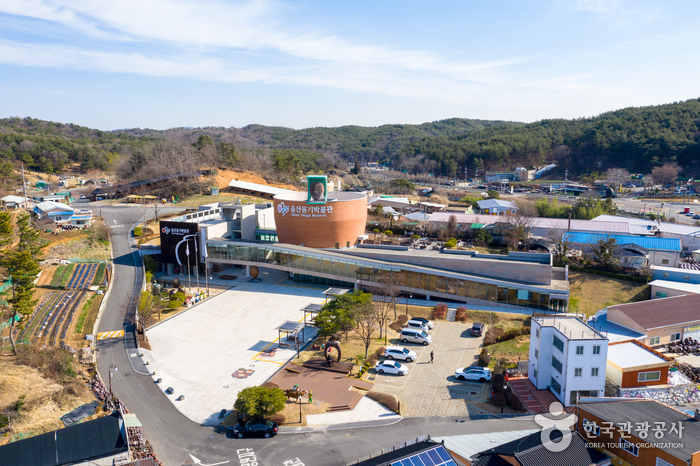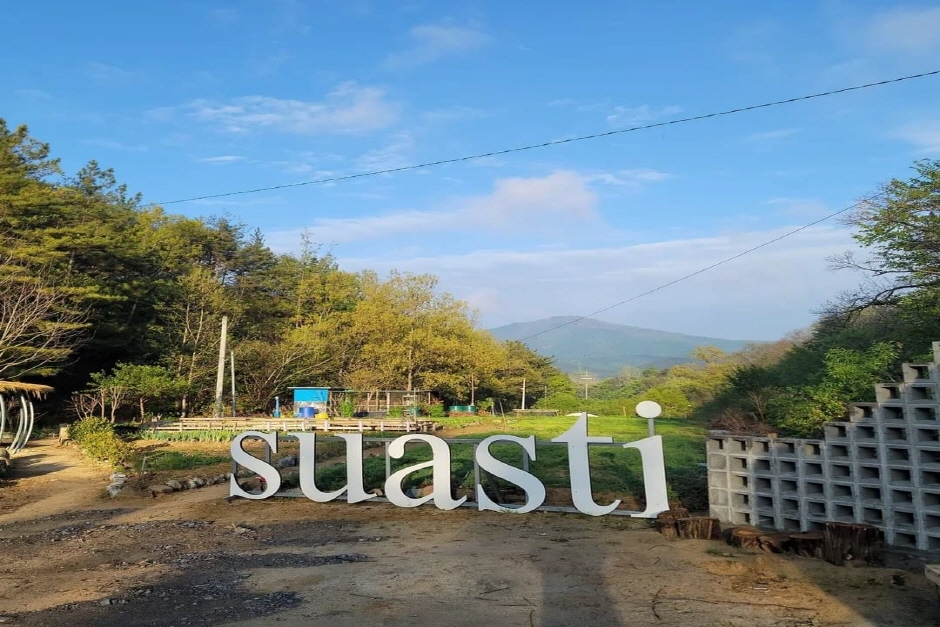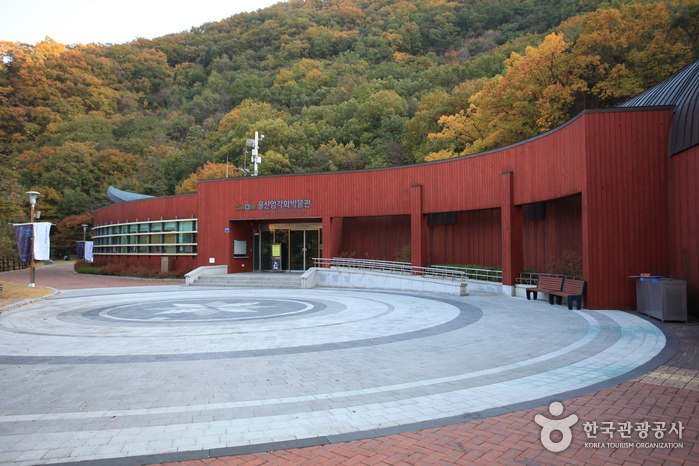Petroglyphs of Bangudae Terrace in Daegok-ri [UNESCO World Heritage] (울주 대곡리 반구대 암각화 [유네스코 세계유산])
15.5Km 2025-07-18
Daegok-ri, Eongyang-eup, Ulju-gun, Ulsan
In Daegok-ri, Eonyang-eup sits Bangudae Terrace, a picturesque spot where a ridge of Yeongosan Mountain extends to and stands tall to form quite a spectacle featuring uniquely shaped rocks and cliffs. The name, Bangudae, comes from how it resembles a turtle lying prone on the ground. Petroglyphs are paintings drawn by people from the prehistoric times carved on rocks and depicting various scenes and events in their daily lives. Petroglyphs were often drawn on enormous rocks and other sacred locations of groups, and it is believed that people gathered around them to hold various rituals.
Petroglyphs of Bangudae Terrace in Daegok-ri, Ulju-gun are estimated to have been drawn over several periods since the New Stone Age, and visitors can observe the differences in styles among various ages. Primary objects that were popularly carved include sea animals, land animals, humans and tools and, as our prehistoric ancestors actively engaged in hunting, the hope of abundance in game is believed to be the reason why these objects were frequently carved on rocks. Vividly expressing animals and hunting scenes and colorfully depicting outstanding traits of objects, these petroglyphs are a form of both hunting art and religious art, and they are considered as the greatest masterpieces that give a peek at the life and customs of the prehistoric ages. The petroglyphs on the Bangudae Terrace and the petroglyphs in Cheonjeon-ri, spanning three kilometers altogether along the Bangucheon Stream, have been inscribed on the UNESCO World Heritage List on July 12, 2025.
Petroglyphs of Cheonjeon-ri [UNESCO World Heritage] (울주 천전리 명문과 암각화 [유네스코 세계유산])
15.9Km 2025-07-18
Cheonjeon-ri, Dudong-myeon, Ulju-gun, Ulsan
The petroglyphs (figures, pictures, and letters were made on the rocks along the mid-stream area of Naegokcheon Stream, which is a tributary of Taehwagang River. The upper and lower sides of the rocks contain petroglyphs that differ in the content and techniques used. The upper side contains petroglyphs made by means of chiseling. The inscriptions include geometric patterns, animals, and abstract human figures. There are concentric circles, with a round figure looking like the sun at the center, four running deer next to them, and several semi-human animals. The figures with simplistic expression and symbolism appear to have been made during the Bronze Age.
The lower side contains line-drawn picture mixed with Chinese characters. They include a procession of horse riders, animals including dragons, and boats. In particular, the procession of horse riders appears in three different places. The boats provide researchers with important information on the offshore activities carried out by people of the Silla dynasty. The 800-plus written characters are about the King and Queen’s visit to the place. They were presumed to have been inscribed on two occasions during the reign of King Beopheung (r. 514-540) of the Silla dynasty. The content on the official positions and the government system makes it a precious material for those studying Silla during or around the 6th Century. The petroglyphs were made by many people over an extended period of time, providing vivid information on the life and thoughts of people from prehistoric times to the Silla dynasty.
The petroglyphs in Cheonjeon-ri and petroglyphs on the Bangudae Terrace, spanning three kilometers altogether along the Bangucheon Stream, have been inscribed on the UNESCO World Heritage List on July 12, 2025.
(Source: Korea Heritage Service)
Ulsan Onggi Festival (울산옹기축제)
16.0Km 2025-07-11
36 Oegosan 3-gil, Onyang-eup, Ulju-gun, Ulsan
+82-52-980-2233
Ulsan Onggi Festival is held annually in early May in Oegosan Onggi Village in Ulju-gun, renowned for its traditional onggi (earthenware)-making techniques. The festival promotes the regional specialty, onggi, contributing to the spread of everyday onggi and the development of traditional industries. The main event, “Touch of the Onggi Master,” features demonstrations by master onggi artisans from Oegosan. There are various hands-on activities for children, including stepping on clay, playing with clay, and making and firing onggi. Visitors can also learn about the uses of onggi in food storage and fermentation, and view onggi from around the world. Don’t miss the opportunity to taste local specialties and foods from Ulju.
◎ Onggi
Onggi is a type of bowl crafted from soil, using water, fire, and wind. This traditional pottery has been produced since the Three Kingdoms period and is well-suited for long-term food storage due to its excellent ventilation and preservative capabilities.
Onggigol Ceramics (옹기골도예)
16.1Km 2025-03-28
18 Oegosan-gil, Ulju-gun, Ulsan
* Please be advised that this is located in one of the areas affected by the recent wildfire (as of March 27, 2025).
** For real-time wildfire information and emergency upates, visit the Korea Forestfire Information website and the National Disaster and Safety Portal.
Onggi Ceramics is the workshop of Heo Jin-gyu, a master onggi craftsman, and is located in Onggi Village in Ulsan, home to the largest production of onggi in the nation. Visitors can browse the items as well as purchase anything that piques their interest. The workshop also offers a range of exerience programs related to onggi, although advanced reservations are required to participate.
Oegosan Onggi Village (외고산옹기마을)
16.2Km 2025-03-28
36, Oegosan 3-gil, Ulju-gun, Ulsan
+82-52-237-7894
* Please be advised that this is located in one of the areas affected by the recent wildfire (as of March 27, 2025).
** For real-time wildfire information and emergency upates, visit the Korea Forestfire Information website and the National Disaster and Safety Portal.
Oegosan Onggi Village was established when earthenware master Heo Deok-man settled in the area in 1975. The village today showcases a massive collection of various earthenware products, which creates a unique sight. Over 50% of the country's earthenware products are crafted at this village. The village also features several attractions for visitors to enjoy, such as the Ulsan Onggi Museum, which houses the largest earthenware pottery recognized by the Guinness Book of World Records; and the annual Ulsan Onggi Festival, with many diverse activity programs.
Vanastha (Healing in Ulju) (와나스타(울주에서 치유하다))
16.2Km 2025-03-28
207 Daeam 1-gil, Eonyang-eup, Ulju-gun, Ulsan
* Please be advised that this is located in one of the areas affected by the recent wildfire (as of March 27, 2025).
** For real-time wildfire information and emergency upates, visit the Korea Forestfire Information website and the National Disaster and Safety Portal.
Vanastha, located in the forest inside Daeam Dam in Ulju-gun, is a forest yoga house that means "stay in the forest." For modern people who lack time to look back on their bodies in their tired daily lives, it provides time to fully focus on themselves with proper breathing, meditation, and Hatha yoga. Here, one can hear the sounds of nature, feel nature, and experience of becoming one with nature and the universe, only in nature. It offers a one-day class and a yoga meditation program on Saturday mornings. Private session option is available for a group of four or more people with a reservation in advance.
Ulsan Petroglyph Museum (울산암각화박물관)
16.2Km 2021-02-22
254, Bangudaean-gil, Ulju-gun, Ulsan
+82-52-229-4797
Ulsan Petroglyph Museum was established on May 30, 2008 at the entrance to Petroglyphs of Bangudae Terrace (National Treasure No. 285) in Ulju-gun. The museum displays 311 exhibit materials and has an exhibition hall, a storage room, a research lab, and an audiovisual room.
The exhibition hall presents models of petroglyphs of Bangudae and petroglyphs of Cheonjeon-ri (National Treasure No. 147), an educational video introducing the petroglyphs, a children’s hall, and family activity facilities. Visitors can observe reproductions of famous petroglyphs at the outdoor exhibit.
Ulsan Daegok Museum (울산대곡박물관)
16.7Km 2021-05-18
257, Seohacheonjeon-ro, Ulju-gun, Ulsan
+82-52-229-4787
Ulsan Daegok Museum displays artifacts that were uncovered from the area of Daegok-ri during the construction of Daegok Dam. Approximately 13,000 relics were excavated during land inspection prior to the dam construction, including Hasamjeong Ancient Tomb. These findings were collected and became available for public display when the museum opened on June 24, 2009.
Padosori Trail (파도소리길)
17.3Km 2025-05-28
405-7 Eupcheon-ri, Yangnam-myeon, Gyeongju-si, Gyeongsangbuk-do
The Padosori (Sound of the Waves) Trail stretches for 1.7 kilometers along the shoreline of Eupcheon-ri in Gyeongju, offering stunning views of the Gyeongju Yangnam Columnar Joint. The coastal road is well-maintained and features a decked pathway, benches, viewing platforms, and a suspension bridge. The Columnar Joint has diverse shapes; in particular, the fan-shaped columnar joint is a rare sight not only in Korea but also worldwide, and thus has been designated as a Natural Monument in 2012.
Gyeongju Yangnam Columnar Joint Observatory (경주 양남 주상절리 전망대)
17.4Km 2023-04-04
498-13 , Donghaean-ro, Gyeongju-si, Gyeongsangbuk-do
+82-54-775-6366
This observatory was built in October 2017 and allows visitors to enjoy the view of columnar joints of Yangnam, a national geopark. The columnar joints are formed along the shoreline of Eupcheon-ri in Yangnam-myeon. Several different forms of columnar joints can be observed from columnar joints that point upward to those that fan out or lean to the side. In particular, the fan-shaped columnar joint is a rare sight not only in Korea but also worldwide, and thus has been designated as a Natural Monument in 2012. Visitors can also see informational exhibits on diverse geographical resources at the observatory as well as ask for a detailed guide by the geology commentator on-site.
![Petroglyphs of Bangudae Terrace in Daegok-ri [UNESCO World Heritage] (울주 대곡리 반구대 암각화 [유네스코 세계유산])](http://tong.visitkorea.or.kr/cms/resource/29/2675629_image2_1.jpg)
![Petroglyphs of Cheonjeon-ri [UNESCO World Heritage] (울주 천전리 명문과 암각화 [유네스코 세계유산])](http://tong.visitkorea.or.kr/cms/resource/14/3335114_image2_1.jpg)





 English
English
 한국어
한국어 日本語
日本語 中文(简体)
中文(简体) Deutsch
Deutsch Français
Français Español
Español Русский
Русский